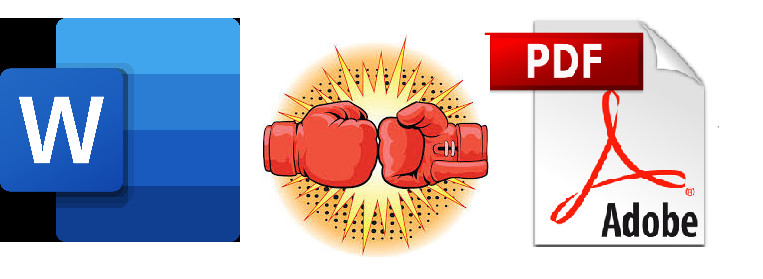Face Off - Microsoft or Adobe for #Accessibility
Creating accessible content is not only important because it is the right thing to do. It is also important because not doing so leaves institutions and businesses at risk for lawsuits and loss of funding.

As accessibility consciousness increases, more and more people are wondering what provider to use to make accessible content? WebAIM (Web Accessibility In Mind)* surveyed preferences of screen reader users comparing Microsoft Word and Adobe PDF.
Creating accessible content is not only important because it is the right thing to do. It is also important because not doing so leaves institutions and businesses at risk for lawsuits and loss of funding.
The verdict?
WebAIM research showed that respondents were much more favorable of Word documents than of PDF documents - 30.9% indicated that Word documents are very or somewhat likely to pose significant accessibility issues, compared to 75.1% for PDF documents.
Implications
Because it is a challenge to make Adobe products accessible, a institutions like Penn State, are suggesting staff avoid Adobe.
Accessible first. Not accessible search.
It’s not that Adobe can’t be made accessible. The problem is it’s not intuitive. For example, the two most important tools for reviewing and repairing PDF accessibility are the Tags pane and the Accessibility tools pane. They are both hidden by default in Acrobat. Accessibility should be the default, not the thing some people search to try to accomplish. Another problem is that several languages are not supported and there is no timeline for a fix.
Heading navigation is key
Regardless of the platform used, the research indicates that navigating headings remains the predominant method for finding page information by those using screen readers. It also makes a page much easier and comfortable for everyone to digest.
Up next?
Let’s put out a challenge for WebAIM to see how Google and Apple fare with feedback from respondents who use screen readers.
Tech & Learning Newsletter
Tools and ideas to transform education. Sign up below.
___________________________________________________________________
*WebAIM (Web Accessibility In Mind) provides comprehensive web accessibility solutions and is a leading provider of web accessibility expertise internationally. WebAIM is a non-profit organization based at the Center for Persons with Disabilities at Utah State University. WebAIM's mission is to expand the potential of the web for people with disabilities by providing the knowledge, technical skills, tools, organizational leadership strategies, and vision that empower organizations to make their own content accessible to people with disabilities.
___________________________________________________________________
cross posted at The Innovative Educator
Lisa Nielsen (@InnovativeEdu) has worked as a public-school educator and administrator since 1997. She is a prolific writer best known for her award-winning blog, The Innovative Educator. Nielsen is the author of several booksand her writing has been featured in media outlets such as The New York Times,The Wall Street Journal, Tech&Learning, and T.H.E. Journal.
Lisa Nielsen (@InnovativeEdu) has worked as a public-school educator and administrator since 1997. She is a prolific writer best known for her award-winning blog, The Innovative Educator. Nielsen is the author of several books and her writing has been featured in media outlets such as The New York Times, The Wall Street Journal, and Tech & Learning.
Disclaimer: The information shared here is strictly that of the author and does not reflect the opinions or endorsement of her employer.
